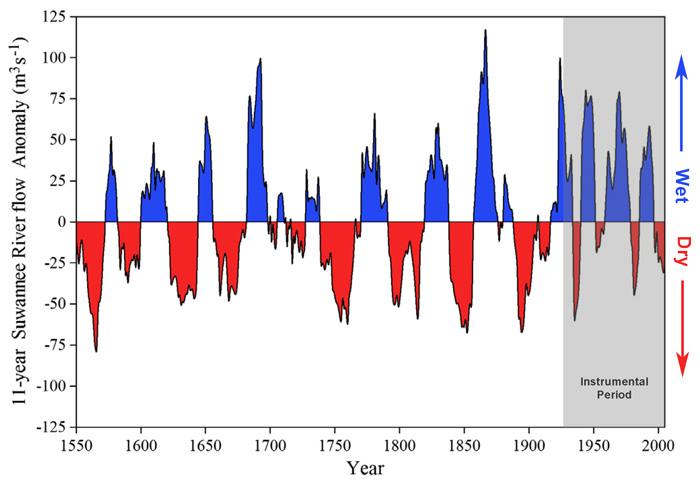| Follow @co2science |
Paper Reviewed
Harley, G.L., Maxwell, J.T., Larson, E., Grissino-Mayer, H.D., Henderson, J and Huffman, J. 2017. Suwannee River flow variability 1550-2005 CE reconstructed from a multispecies tree-ring network. Journal of Hydrology 544: 438-451.
In the climate change debate today, one of the more frequent (and false) claims made by the ill-informed is that human-caused global warming is making extreme weather events more frequent and more severe. And despite much data to the contrary, many activist scientists are now further claiming that each and every drought, flood, hurricane, tornado and wildfire, along with every other imaginable extreme weather event, is principally caused, and made worse, by rising atmospheric CO2 concentrations.
The folly of such claims, however, is easily exposed by long-term data sets that go beyond the instrumental period. Such records reveal the true nature of natural climate variability and invariably show that present-day extreme weather events are in nearly every case eclipsed in frequency and magnitude by events from the historic past. And because such historic events occurred prior to the bulk of societal industrialization and the modern buildup of CO2 in the atmosphere, there is zero chance that those historic events were human caused. Recognizing these facts, as long as current extreme weather events remain within the realm of natural variability observed over the recent historic past, one cannot conclude with any degree of certainty that current extreme weather events have any anthropogenic or human-induced component in them. Stated another way, one simply cannot reject the hypothesis that such events are entirely natural.
A case in point can be made in viewing the recent study of Harley et al. (2017). Over the period 1927-2010, streamflow data from the Suwannee River, which according to the authors is the second largest river system in Florida (USA) and the least impacted by human disturbance, reveal multiple periods of flood (high flow) and drought (low flow) superimposed on a long-term linear decline in discharge rate that led to recently recorded low flows. Given as much, it might be quite tempting for some to claim that CO2-induced global warming is causing an increase in drought in this region over the past few decades, especially during the period of record low monthly flows observed during 2010 and 2011 that caused "widespread negative impacts on the economy and ecology of the basin." But would such attribution be correct?
Answering this question appeared to be the objective of the team of six researchers, who wanted to place the instrumental Suwannee River flow variability into a broader temporal framework, where it was their aim to "provide context for recent drought events that occurred in the basin, most notably 1999-2002 and 2005-2006, and to better understand the likelihood of meeting or exceeding these conditions in the future." To accomplish their objective, Harley et al. analyzed new and existing tree-ring chronologies from multiple tree species to produce a reconstruction of March through October Suwannee River discharge for the past 450 years.
Results of their analysis are shown in the figure below, which presents an 11-year running mean of standardized river flow anomalies relative to the long-term mean (1550-2005). As can be seen there, the most intense and prolonged wet and dry periods did not occur during the instrumental record. Rather, they occurred during the historic past long before humanity increased the CO2 concentration of the atmosphere by any significant amount. What is more, it is interesting to note the "drastic hydroclimatic shift" from extremely dry to extremely wet conditions that occurred naturally around 1860. And as for the cause(s) of the streamflow variability, Harley et al. report finding multiple periodicities in the reconstructed data (2-5, 7, 11, 45 and 85 year bands, p < 0.05), which periodicities, they suggest, indicate "the important influence of coupled oceanic-atmospheric processes" over the past four-and-a-half centuries.

Figure 1. Historic streamflow of the Suwannee River based on an 11-year running mean of standardized river flow anomalies relative to the long-term mean (1550-2005). Adapted from Harley et al. (2017).
The take-home message of Harley et al.'s work is summarized in their statements that (1) "we found that instrumental period flow conditions do not adequately capture the full range of variability of the Suwannee River beyond the observational period," and (2) wet-period "pluvials and droughts that eclipse instrumental events in terms of severity and duration have occurred during the 16-19th centuries," which latter finding they add is "echoed by other studies of long-term precipitation variability in the Southeast U.S. (e.g., Stahle and Cleaveland, 1992; Cook et al., 2007; Seager et al., 2009)."
Clearly, therefore, based on the material presented in the work of Harley et al., there is no discernible human impact on Suwannee River streamflow over the instrumental record; and there is no compelling reason to conclude that anything other than natural climate variability has contributed to the extreme wet and dry periods observed in this portion of the globe over the past 450 years. Consequently, the next time you hear a climate-alarmist claim that a given extreme weather event is human-caused, remember to approach it with a skeptical scientific mind until you know how it fits within a broader historical context.
References
Cook, E.R., Seager, R., Cane, M.A. and Stahle, D.W. 2007. North American drought: reconstructions, causes, and consequences. Earth Science Reviews 81: 93-134.
Seager, R., Tzanova, A. and Nakamura, J. 2009. Drought in the southeastern United States: causes, variability over the last millennium, and the potential for future hydroclimate change. Journal of Climate 22: 5021-5045.
Stahle, D.W. and Cleaveland, M.K. 1992. Reconstruction and analysis of spring rainfall over the southeastern US for the past 1000 years. Bulletin of the American Meteorological Society 73: 1947-1961.
Posted 25 April 2017



